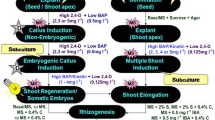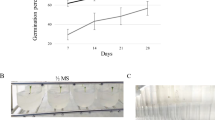Abstract
Halogeton glomeratus (H. glomeratus) is one of the most important halophytes in Asia, and the research on the genes and salt-tolerant mechanisms of this species is limited because of the lack of an optimal and efficient in vitro regeneration system. Here, we developed an efficient plant regeneration protocol using H. glomeratus leaves as explants, which has not been previously reported. High-quality calli were successfully obtained from the H. glomeratus leaves at a frequency of 100% supplemented with 2.00 mg/L 2,4-dichlorophenoxyacetic acid, 0.50 g/L PVP, 5.00 g/L agar, and 30.00 g/L sucrose; the optimum callus subculture medium is 1.00 mg/L 2,4-dichlorophenoxyacetic acid, 0.50 g/L PVP, 5.00 g/L agar, and 30.00 g/L sucrose. Shoots were regenerated on shoot induction medium at a frequency of 100% added with 0.50 mg/L 6-benzylaminopurine, 2.00 mg/L kinetin, 0.20 mg/L naphthaleneacetic acid, 0.50 g/L PVP, 5.00 g/L agar, and 30.00 g/L sucrose; then, shoots grew up on shoot regeneration medium. Finally, roots were regenerated from the shoots on Murashige and Skoog medium with high efficiency. This study firstly offers a rapid and efficient system for plantlet regeneration from leaves of H. glomeratus. Whether our protocol applies well to other tissue regeneration of H. glomeratus needs further confirmation. This work will facilitate basic research and salt-tolerant mechanisms of this important halophyte species.





Similar content being viewed by others
References
Ampomah-Dwamena C, Conner AJ, Fautrier AG (1997) Genotypic response of lettuce cotyledons to regeneration in vitro. Sci Hortic (Amsterdam) 71:137–145. https://doi.org/10.1016/S0304-4238(97)00098-8
Armas I, Pogrebnyak N, Raskin I (2017) A rapid and efficient in vitro regeneration system for lettuce (Lactuca sativa L.). Plant Methods 13:578. https://doi.org/10.1186/s13007-017-0208-0
Ball ST, Zhou HP, Konzak CF (1993) Influence of 2,4-D, IAA, and duration of callus induction in anther cultures of spring wheat. Plant Sci 90:195–200. https://doi.org/10.1016/0168-9452(93)90240-Z
Binh DQ, Heszky LE, Gyulai G, Kiss E, Csillag A (1989) Plant regeneration from callus of Puccinellia distans (L.) Parl. Plant Cell Tissue Organ Cult 18:195–200. https://doi.org/10.1007/BF00047745
Chand S, Sahrawat AK (2001) Stimulatory effect of partial desiccation on plant regeneration in indica rice (Oryza sativa L). J Plant Biochem Biotechnol 10:43–47. https://doi.org/10.1007/BF03263105
Duncan DB (1955) Multiple range and multiple F tests. Biometrics 11:1–42. https://doi.org/10.2307/3001478
Gharari Z, Bagheri K, Sharafi A, Danafar H (2019) Thidiazuron induced efficient in vitro organogenesis and regeneration of Scutellaria bornmuelleri: an important medicinal plant. Vitro Cell Dev Biol - Plant 55:133–138. https://doi.org/10.1007/s11627-019-09965-7
Grando MF, Franklin CI, Shatters RG (2002) Optimizing embryogenic callus production and plant regeneration from ‘Tifton 9’ bahiagrass seed explants for genetic manipulation. Plant Cell Tissue Organ Cult 71:213–222. https://doi.org/10.1023/A:1020303522530
Ji XH, Wang YT, Zhang R, Wu SJ, An MM, Li M, Wang CZ, Chen XL, Zhang YM, Chen XS (2015) Effect of auxin, cytokinin and nitrogen on anthocyanin biosynthesis in callus cultures of red-fleshed apple (Malus sieversii f.niedzwetzkyana). Plant Cell Tissue Organ Cult 120:325–337. https://doi.org/10.1007/s11240-014-0609-y
Li LH, Yang GP, Ren MJ, Wang ZN, Peng YS, Xu RH (2020) Co-regulation of auxin and cytokinin in anthocyanin accumulation during natural development of purple wheat grains. J Plant Groeth Regul. https://doi.org/10.1007/s00344-020-10237-7
Liang HZ, Xiong YP, Guo BY, Yan HF, Jian SG, Ren H, Zhang XH, Li Y, Zeng SJ, Wu KL, Zheng F, Silva JT, Xiong YH, Ma GH (2020) Shoot organogenesis and somatic embryogenesis from leaf and root explants of Scaevola sericea. Sci Rep 10(1):11343. https://doi.org/10.1038/s41598-020-68084-1
Liu GS, Liu JS, Qi DM, Chu CC, Li HJ (2004) Factors affecting plant regeneration from tissue cultures of Chinese leymus (Leymus chinensis). Plant Cell Tissue Organ Cult 76:175–178. https://doi.org/10.1023/B:TICU.0000007251.96785.18
Lu D, Wei W, Zhou W, Mcguigan LD, Ji FY, Li X, Xing Y, Zhang Q, Fang KF, Cao QQ (2017) Establishment of a somatic embryo regeneration system and expression analysis of somatic embryogenesis-related genes in Chinese chestnut (Castanea mollissima Blume). Plant Cell Tissue Organ Cult 130:601–616. https://doi.org/10.1007/s11240-017-1250-3
Makunga NP, Staden JV, Cress WA (1997) The effect of light and 2,4-D on anthocyanin production in Oxalis reclinata callus. Plant Growth Regul 23:153–158. https://doi.org/10.1023/A:1005966927813
Martínez-Estrada E, Caamal-Velázquez JH, Salinas-Ruíz J, Bello-Bello JJ (2017) Assessment of somaclonal variation during sugarcane micropropagation in temporary immersion bioreactors by intersimple sequence repeat (ISSR) markers. Vitro Cell Dev Biol - Plant 53(6):553–560. https://doi.org/10.1007/s11627-017-9852-3
Mohebodini M, Javaran MJ, Mahboudi F, Alizadeh H (2011) Effects of genotype, explant age and growth regulators on callus induction and direct shoot regeneration of Lettuce (Lactuca sativa L.). Aust. J Crop Sci 5:92–95. https://doi.org/10.2134/agronj2010.0160s
Morini S, D'Onofrio C, Bellocchi G, Fisichella M (2000) Effect of 2,4-D and light quality on callus production and differentiation from in vitro cultured quince leaves. Plant Cell Tissue Organ Cult 63:47–55. https://doi.org/10.3732/ajb.90.11.1548
Murashige T, Skoog F (1962) A revised medium for rapid growth and bio assays with tobacco tissue cultures. Physiol Plant 15:473–497. https://doi.org/10.1111/j.1399-3054.1962.tb08052.x
Neelakandan AK, Wang K (2012) Recent progress in the understanding of tissue cultured-induced genome level changes in plants and potential applications. Plant Cell Rep 31:597–620. https://doi.org/10.1007/s00299-011-1202-z
Othmani A, Bayoudh C, Drira N, Marrakchi M, Trifi M (2009) Somatic embryogenesis and plant regeneration in date palm Phœnix dactylifera L., cv. Boufeggous is significantly improved by fine chopping and partial desiccation of embryogenic callus. Plant Cell Tissue Organ Cult 97:71–79. https://doi.org/10.1007/s11240-009-9500-7
Özcan S, Barghchi M, Firek S, Draper J (1992) High frequency adventitious shoot regeneration from immature cotyledons of pea (Pisum sativum L.). Plant Cell Rep 11:44–47. https://doi.org/10.1007/BF00231838
Ozeki Y, Komamine A (1986) Effects of growth regulators on the induction of anthocyanin synthesis in carrot suspension cultures. Plant Cell Physiol 27:1361–1368. https://doi.org/10.1007/s12155-011-9177-8
Rosnow J, Offermann S, Park J, Okita TW, Tarlyn N, Dhingra A, Edwards GE (2011) In vitro cultures and regeneration of Bienertia sinuspersici (Chenopodiaceae) under increasing concentrations of sodium chloride and carbon dioxide. Plant Cell Rep 30:1541–1553. https://doi.org/10.1007/s00299-011-1067-1
Shi XL, Han HP, Shi WL, Li YX (2006) NaCl and TDZ are two key factors for the improvement of in vitro regeneration rate of Salicornia europaea L. J Integr Plant Biol 48:1185–1189. https://doi.org/10.1111/j.1744-7909.2006.00342.x
Shimomae K, Dongpoh C, Khan RS, Mii M (2013) Efficient plant regeneration system from seed-derived callus of ravenna grass [Erianthus ravennae (L.) Beauv.]. Plant Biotechnol J 30:473–478. https://doi.org/10.5511/plantbiotechnology.13.0721a
Singh SR, Singh R, Kalia S, Dalal S, Dhawan AK, Kalia RK (2013) Limitations, progress and prospects of application of biotechnological tools in improvement of bamboo-a plant with extraordinary qualities. Physiol Mol Biol Plants 19:21–41. https://doi.org/10.1007/s12298-012-0147-1
Skoog F, Miller CO (1957) Chemical regulation of growth and organ formation in plant tissues cultured in vitro. Symp Soc Exp Biol 27:118–130. https://doi.org/10.1002/chin.199621020
Sun YL, Hong SK (2009) Somatic embryogenesis and in vitro plant regeneration from various explants of the halophyte Leymus chinensis (Trin.). Plant Biotechnol J 36:236–243. https://doi.org/10.5010/JPB.2009.36.3.236
Sun YL, Hong SK (2010) Effects of plant growth regulators and l-glutamic acid on shoot organogenesis in the halophyte Leymus chinensis (Trin.). Plant Cell Tissue Organ Cult 100:317–328. https://doi.org/10.1007/s11240-009-9653-4
Syōno K (1965) Changes in organ forming capacity of carrot root calluses during subcultures. Plant Cell Physiol 6:403–419. https://doi.org/10.1098/rstb.1965.0005
Wang JC, Li BC, Meng YX, Ma XL, Lai Y, Si EJ, Yang K, Ren PR, Shang XW, Wang HJ (2015) Transcriptomic profiling of the salt-stress response in the halophyte Halogeton glomeratus. BMC Genomics 16:169. https://doi.org/10.1186/s12864-015-1373-z
Wang JC, Meng YX, Li BC, Ma XL, Lai Y, Si EJ, Yang K, Xu XL, Shang XW, Wang HJ (2015) Physiological and proteomic analyses of salt stress response in the halophyte Halogeton glomeratus. Plant Cell Environ 38:655–669. https://doi.org/10.1111/pce.12428
Wang JC, Yao LR, Li BC, Meng YX, Ma XL, Lai Y, Si EJ, Ren PR, Yang K, Shang XW (2016) Comparative proteomic analysis of cultured suspension cells of the halophyte Halogeton glomeratus by iTRAQ provides insights into response mechanisms to salt stress. Front Plant Sci 7:110. https://doi.org/10.3389/fpls.2016.00110
Wang Z, Hopkins A, Mian R (2001) Forage and turf grass biotechnology. Crit Rev Plant Sci 20(6):573–619. https://doi.org/10.1016/S0735-2689(01)80005-8
Wei Q, Cao JJ, Qian WJ, Xu MJ, Li ZR, Ding YL (2015) Establishment of an efficient micropropagation and callus regeneration system from the axillary buds of Bambusa ventricosa. Plant Cell Tissue Organ Cult 122:1–8. https://doi.org/10.1007/s11240-015-0743-1
Xinrun Z, Conner AJ (1992) Genotypic effects on tissue culture response of lettuce cotyledons. J Genet Breed 46:287–290
Ye SW, Cai CY, Ren HB, Wang WJ, Xiang MQ, Tang XS, Zhu CP, Yin TF, Zhang L, Zhu Q (2017) An efficient plant regeneration and transformation system of Ma Bamboo (Dendrocalamus latiflorus Munro) started from young shoot as explant. Front Plant Sci 8:1298. https://doi.org/10.3389/fpls.2017.01298
Yeh ML, Chang WC (1986) Somatic embryogenesis and subsequent plant regeneration from inflorescence callus of Bambusa beecheyana Munro var. beecheyana. Plant Cell Rep 5:409–411. https://doi.org/10.1007/BF00269628
Yeh ML, Chang WC (1987) Plant regeneration via somatic embryogenesis in mature embryo-derived callus culture of Sinocalamus latiflora (Munro) McClure. Plant Sci 51:93–96. https://doi.org/10.1016/0168-9452(87)90224-X
Zang QL, Jiao YL, Guo XM, Fei Z, Yeh K, Lin X (2016) Callus induction and plant regeneration from lateral shoots of herbaceous bamboo Mniochloa abersend. J Hortic Sci Biotechnol 92:168–174. https://doi.org/10.1080/14620316.2016.1232610
Funding
This work was supported by the Open Funds of Laboratory of Gansu Agricultural University (Grant GSCS-2019-07), National Natural Science Foundation of China (Grant 31960072, 32001514), Innovation Capacity Enhancement Project of Gansu Education Department (Grant 2019A-053), China Agriculture Research System (Grant CARS-05-04B-2), Key Projects of Natural Science Foundation of Gansu Province (20JR10RA507), National Basic Research Program of China (973 program, 2014CB160313), National University Innovation and Entrepreneurship Training Program (202010733004, 202010733003), and Scientific Research Start-Up Funds for Openly-Recruited Doctors of Gansu Agricultural University (Grant GAU-KYQD-2018-22, 02).
Author information
Authors and Affiliations
Contributions
HW and XS designed the experiments. LY, JW, BL, YM, ES, and KY performed the experiments. LY, JW, XM, YL, and PR observed the morphologic changes of explants and analyzed the data. LY wrote the manuscript. All authors read and approved the final manuscript.
Corresponding author
Ethics declarations
Competing interests
The authors declare no competing interests.
Additional information
Editor: Yong Eui Choi
Rights and permissions
About this article
Cite this article
Yao, L., Wang, J., Yang, K. et al. In vitro regeneration system of Halogeton glomeratus: an important halophyte. In Vitro Cell.Dev.Biol.-Plant 57, 332–340 (2021). https://doi.org/10.1007/s11627-021-10169-1
Received:
Accepted:
Published:
Issue Date:
DOI: https://doi.org/10.1007/s11627-021-10169-1




